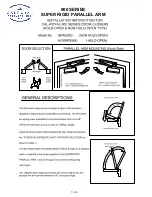
Issued / Herausgegeben / Publicado / Publication
03/2002
V10946
Publicatto / Udgivet / Afgegeven / Utgiven
179-724, 712-012
Gland Type Valves
It is recommended that the Oxygen and Fuel-gas valves fitted to
shanks and cutting attachments are regularly checked for correct
adjustment. The gland-nut should be adjusted when necessary in a
clockwise direction in order to create a light interference feel when
operating the valve.
Rubber Hose
Use only hose in good condition, fitted with special hose connections
attached by permanent ferrules. Do not expose the hose to heat, oil or
grease, traffic, slag or sparks from welding or cutting operations. Scrap
any hose as soon as it becomes leaky. Good hose will re-pay the cost
many times by long life, safe operation and elimination of waste
through leaks.
Pressure Regulators
Always treat a regulator as a precision instrument. Do not expose it to
knocks, jars or violent pressure changes caused by the sudden
opening of the cylinder valve. Release the pressure on the control
spring when shutting down. Never use a regulator on any gas except
that for which it was designed. Do not use regulators with broken
gauges.
Blowpipes/Cutters
For lighting up and extinguishing any type of blowpipe, the maker’s
instructions should always be followed. To clean the nozzle, use the
supplied nozzle cleaner set.
Goggles
Goggles of the correct type should be worn at all time during welding
and cutting.
Assembly of Equipment
1.
Stand both cylinders vertically. Oxygen cylinders are painted
black, Acetylene cylinders are painted maroon and Propane
cylinders are painted red.
2.
Ensure that jointing surfaces in cylinder valves and regulators are
FREE FROM OIL AND GREASE.
3.
Open the valve on the oxygen cylinder momentarily in order to
shift the cylinder valve and dislodge dirt or obstructions. Close the
valve.
4.
Open the fuel-gas cylinder valve as in item 3 above.
5.
Screw the oxygen regulator into the oxygen cylinder valve. The
cylinder valve, the regulator inlet stem and the regulator outlet
connections have right-hand screwed threads.
6.
Screw the fuel-gas regulator into the gas cylinder valve. The
cylinder valve, the regulator inlet and the regulator outlet
connections have left-hand screwed threads.
7.
Tighten the regulator into the cylinder valve. Do not use excessive
force, but make certain that the joints are gas- tight.
8.
Connect the hoses to the screwed outlets of the regulators by
means of the screwed connections secured in the ends of each
hose. Blow the hose through before attaching to regulator or to
blowpipe in order to remove dust, dirt, or chalk when the hose is
new. OXYGEN MUST NOT BE USED FOR THIS PURPOSE.
9.
Connect the end of the hose fitted with a check-valve to the
blowpipe. Fit the fuel gas hose to the left-hand connection and the
oxygen hose to the right-hand connection. Keep the blowpipe
control valves closed.
10.
Fit the appropriate sized nozzle to the blowpipe. To obtain the best
possible results from RS blowpipes, always use RS precision
nozzles.
Lighting-up Procedure
Welding Blowpipes
1. Use the cylinder key to slowly open cylinder valves one turn only.
Do not open suddenly or there may be serious damage to the
regulator and the possibility of an accident.
2. Open the fuel-gas control valve on the blowpipe and adjust the
regulator to give the correct working pressure (this ensures any
air or oxygen is purged from the hose).
3. Repeat the above procedure for the oxygen side.
4. Open the fuel gas control valve and light the gas, preferably by
means of an RS spark-lighter, making sure that the spark-lighter
is held at right angles to the nozzle.
5. Reduce or increase the acetylene supply to the blowpipe valve
until the flame just ceases to smoke.
6. Slowly turn on the oxygen by the blowpipe control valve until the
white inner cone in the flame is sharply defined with the merest
trace of an acetylene haze. The blowpipe is now correctly
adjusted for welding.
RS
Stock No.
Combined Welding and Cutting Kit
Allgemeine Sicherheitshinweise fur Schweiss-
und Schneideinrichtungen
Precauciones Generales de Seguridad para
equipos de Soldadura y Corte
Précautions Générales pour l’utilisation du
Matérial de Soudage et de Coupage
Precauzioni Generali di Sicurezza per
Attrezzatura da Saldatura e da Taglio.
DK
Generelle Sikkerhedsforanstaltninger
Forsvejse - og Skæreudstyr
NL
Algemene Veiligheidsvoorschriften voor
Las-en Snijapparatuur.
SE
Allmänna Säkerhetsmått för Svetsnings- och
Skärningsutrustning
Instruction Leaflet
Bedienungsanleitung
Hojas de instrucciones
Feuille d’instructions
Foglio d’instruzioni
Betjeningsvejledning
Instructies
Instruktionsfolder


































